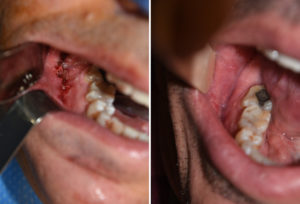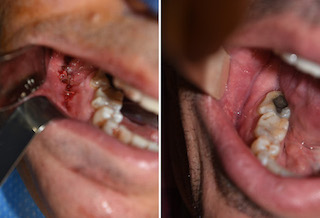The most common approach for jaw angle implant placement is intraoral. This not only avoids an external approach but provides the widest exposure of the mandibular ramus. This incision is made through a posterior vestibular mucosal incision. There are various thoughts on where it should be placed directly into the depth of the vestibule or just above it on the cheek side. I prefer the latter as it leaves a thicker cuff of soft tissue on the tooth side of the incision for a competent closure.
While the intraoral vestibular approach is the best point of access for jaw angle implant placement, it is also a tissue site that gets weaker with each incisional opening. This is relevant in cases of revisional procedures to adjust the implant or in secondary surgery for implant replacement due to size or shape issues. The v-shape of the vestibule combined with its naturally deep depth makes always runs the risk of failure to heal with exposure of the superior part of the implant.
Once non-healing of the posterior vestibular incisions occurs, it is very hard to just freshen up the edges and expect it to heal. This is because the problem is one of tissue deficiency at that point not just an open wound. The vestibular tissues thin out and, on top of that, become scarred with decreased vascularity.

Transferring new vascularized tissue is one of the fundamental principles of plastic surgery in the management of complex wounds. The use of the neighboring buccal fat pad, often discarded for aesthetic cheek contouring, is a useful technique for jaw angle implant coverage when the incisional wound edges are compromised.
Dr. Barry Eppley
Indianapolis, Indiana




